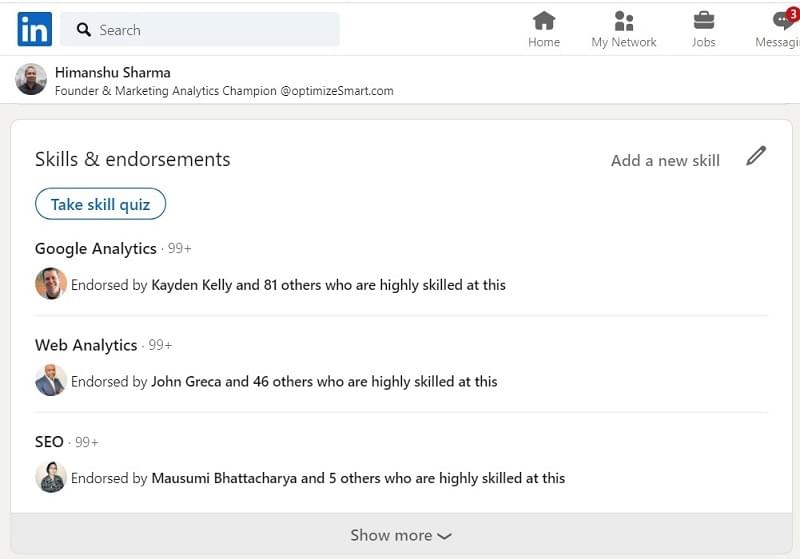Understanding the data layer is the key to getting the most out of Google Tag Manager


Get the only ebook on Data Layers ever published (100+ pages):
Google Tag Manager Data Layers
Founder of OptimizeSmart.com
In the context of GTM, a data layer is a JavaScript array that is used to collect and store data from a website and then send that data to GTM (aka the container tag).
Google recommends using data layers, for retrieving run time information.
A data layer provides a safer and reliable way to pull data from your website and send it to GTM.
When you pull data directly from your website (by traversing the HTML DOM) and push it into your analytics and marketing tags (via GTM), you create an unreliable tracking setup.
This happens because a typical website updates all the time.
So any change in the HTML DOM (structure of HTML) can break your tracking set up any day, any time without any prior notice.
To fix this problem, we create and use data layers, which stores all the information we want to collect about a web page.
Once we have set up the data layer, we pull data directly from the data layer instead of the HTM DOM of the page.
That's why understanding the data layer is the key to getting the most out of Google Tag Manager.
But you can create and use data layers only when you understand the JavaScript behind it.
What is so different about this book is that firstly it is the only book on data layers ever published.
Second, it actually teaches you the JavaScript required to create a data layer.
All other resources on data layers assume that you already know JavaScript or they simply tell you to figure it out on your own.
But you really cannot create, use or even understand data layers, if you do not understand the JavaScript behind them.
Table of Contents
- #1 Why JavaScript?
- #2 Role of JavaScript in a Web Document
- #3 How to add JavaScript to a Web Document
- #4 Introduction to JavaScript statements
- #5 Order of execution of JavaScript Statements
- #6 JavaScript and White Spaces
- #7 Introduction to Comments in JavaScript
- #8 Introduction to JavaScript Variables
- #9 The Assignment Operator
- #10 How to use the value of a JavaScript Variable
- #11 Rules for naming JavaScript Variables
- #12 Best practices for creating variable names in JavaScript
- #13 Introduction to JavaScript Keywords
- #14 Data Types in JavaScript
- #15 Strings in JavaScript
- #16 Introduction to Data Layer
- #17 Advantage of using a Data Layer
- #18 Data layer vs DOM scraping
-
#19 Introduction to Arrays in JavaScript
- #20 How to create an Array Variable
- #21 Introduction to Objects in JavaScript
- #22 Introduction to Data Layer Variables
- #23 Initializing a Data Layer Variable
-
#24 How to push information into a Data Layer
- #25 Overwriting the value of data layer variable
-
#26 Dynamic data layer variables
-
#27 Introduction to 'event' data layer variable
-
#28 Guidelines for naming data layer variables
-
#29 Renaming a data layer
- #30 Introduction to Universal data layer
- #31 gtm.js, gtm.dom and gtm.load events
- #32 How to inspect the data layer on a web page
-
#33 Data Layer Variable in Google Tag Manager
- #34 Data Layers FAQ
When you get a copy of this ebook, you also get the following TWO bonuses for FREE:
BONUS-1: Google Tag Manager Audit Checklist (29 pages)

BONUS-2: Server Side Tracking via GTM (83 pages)

You probably know that an increasing number of users are now using ad blockers. And browsers continue to restrict access to more and more users' data.
All of these tracking restrictions are creating big data gaps on the conversion paths and making it very difficult to understand customers' purchase journeys and advertise profitably.
So how do you track users’ data then? Is this the end of website tracking as we know it? No.
It is actually the dawn of new and more powerful tracking called ‘server-side tracking‘. You need to switch from client-side to server-side tagging.
You move all your tracking pixels to the server-side. Whether it is Google Analytics, or GA4 or Google ads.
Look what existing readers have to say about this ebook











About the Author

- Founder, OptimizeSmart.com
- Over 15 years of experience in digital analytics and marketing.
- Author of four best-selling books on digital analytics and conversion optimization
- Nominated for Digital Analytics Association Awards for Excellence.
- Runs one of the most popular blogs in the world on digital analytics.
- Consultant to countless small and big businesses over the decade.


- Founder, OptimizeSmart.com
- Over 15 years of experience in digital analytics and marketing.
- Author of four best-selling books on digital analytics and conversion optimization
- Nominated for Digital Analytics Association Awards for Excellence.
- Runs one of the most popular blogs in the world on digital analytics.
- Consultant to countless small and big businesses over the decade.

Where should I send your ebook?




Copyright © 2025 OptimizeSmart.com - All rights reserved | Privacy Policy and Terms of Use